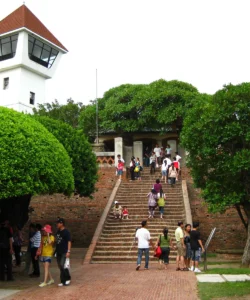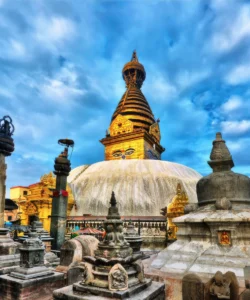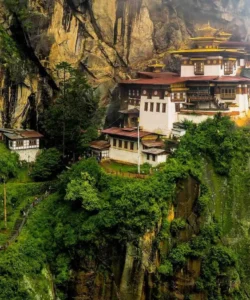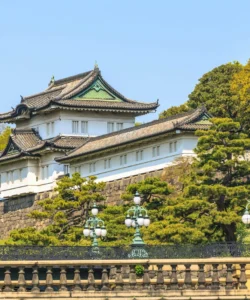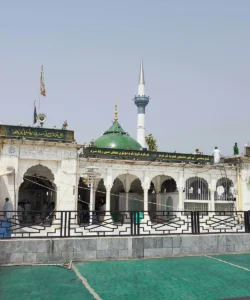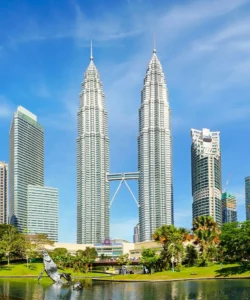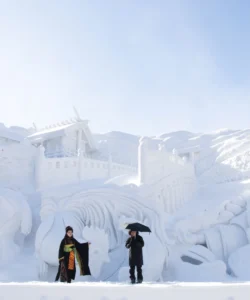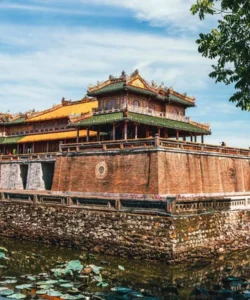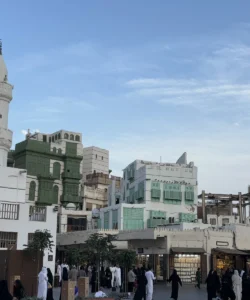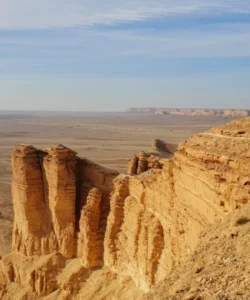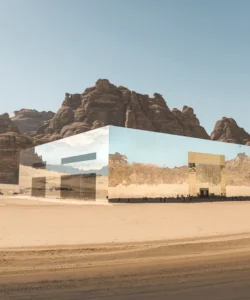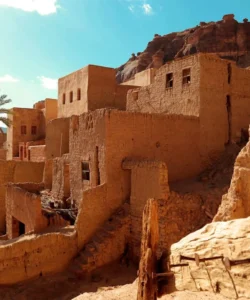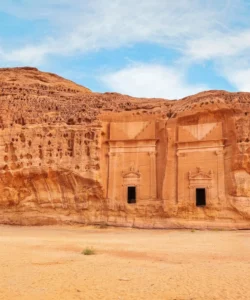Maraya (Arabic: مرايا, meaning “mirrors” or “reflection”) is an extraordinary architectural marvel and a multi-purpose concert hall located in the AlUla desert, Saudi Arabia. It is globally famous for being the world’s largest mirrored building, designed to seamlessly blend into and reflect the breathtaking natural landscape of the ancient Ashar Valley.
Name: Maraya (officially Maraya Concert Hall or Maraya Auditorium)
Address: Ashar Valley, AlUla, Medina Province, Saudi Arabia. It is situated within the AlUla Oasis, a short distance from the ancient city of AlUla and the UNESCO World Heritage site of Hegra, making it a central component of the region’s cultural and tourism development.
How to Get There:
Access to Maraya, like other attractions in AlUla, is highly managed. Self-driving directly to the building’s immediate vicinity may be restricted, and visits are often part of organized tours or require specific bookings.
- By Air to AlUla (ULH): The most convenient way is to fly directly into AlUla International Airport (ULH). Domestic flights connect from major Saudi cities (Riyadh, Jeddah, Dammam), and international flights may be available (e.g., from Dubai). From the airport, it’s about a 40-minute drive to Maraya.
- By Road to AlUla: AlUla is accessible by road from major cities in Saudi Arabia.
- From Medina: Approximately 350 km (4 hours) drive.
- From Jeddah: Approximately 8 hours drive.
- Renting a car in Saudi Arabia and driving to AlUla allows for broader exploration of the region, but specific access to Maraya’s immediate surroundings is often controlled.
- From AlUla Town to Maraya:
- Organized Tours (Recommended): The official “Experience AlUla” tours often include Maraya, providing transport from central visitor areas like Winter Park or directly from the Hegra Visitor Centre.
- Maraya Tour: Dedicated tours specifically for Maraya (approximately 1 hour in duration) can be booked in advance via the official AlUla website (ExperienceAlUla.com). These tours usually include a professional guide and access to the Maraya Cafe and Gift Shop.
- Patrons of Maraya Social or nearby resorts: Guests dining at Maraya Social (the rooftop restaurant) or staying at luxury resorts like Banyan Tree AlUla or Habitas AlUla (which are within Ashar Valley) are typically granted access to the exterior of the building.
- Important Note: Entry to the interior of Maraya (the auditorium itself) is generally exclusively reserved for attendees of specific events or those holding their own events.
- Best Time to Visit: The cooler months from October to April are ideal for visiting AlUla. The building is designed to reflect the natural light, so daytime visits (especially morning or late afternoon for softer light) are excellent for photography.
Landscape and Architecture:
Maraya’s “architecture” is a revolutionary blend of art, engineering, and environmental integration, designed to create a visual dialogue with its stunning natural desert setting.
- World’s Largest Mirrored Building: This is its defining architectural feature. Maraya is a massive cuboid structure (100x100x26 meters, or roughly 328x328x85 feet) entirely clad in 9,740 square meters (approximately 105,000 square feet) of custom-made mirrored glass panels. This extraordinary exterior holds the Guinness World Record as the largest mirrored building ever constructed.
- Reflection of the Landscape: The primary design philosophy, by Giò Forma Architects and Black Engineering, was that “if a building cannot compete with the landscape it should enhance it.” Maraya achieves this by acting as a gigantic, respectful mirror, reflecting the ancient, wind-carved sandstone mountains, vast desert sky, and surrounding natural beauty of the Ashar Valley. From a distance, it appears like a shimmering mirage, almost disappearing into its surroundings, while up close, it offers perfect, often distorted, reflections.
- Cuboid Steel Frame: The underlying structure is a robust cuboid steel frame, meticulously engineered to support the extensive mirrored cladding. The mirrors themselves were specially developed by Guardian Glass to withstand the extreme desert conditions, including intense UV light, high temperatures, sandstorms, and corrosion.
- Retractable Giant Window: A unique feature is a gigantic retractable window (40m x 15m, over 800 sq m) at the rear of the stage. This massive facade can be opened, allowing the stunning desert landscape to become an integral part of performances or events, effectively turning the natural surroundings into a living stage backdrop.
- Integrated Interior Design: The interior of the 500-seat auditorium and its surrounding spaces (foyer, lounge, VIP boxes) features a refined aesthetic. The color palette and textures are inspired by the surrounding desert, creating a harmonious transition from the exterior reflections to the inner experience.
- Multi-Purpose Venue: Beyond being a concert hall, Maraya is designed as a versatile venue for various events, including conferences, exhibitions, galas, and product launches. It features state-of-the-art audiovisual technology and excellent acoustics.
- Rooftop Restaurant (Maraya Social): On its rooftop, the building hosts “Maraya Social,” a fine-dining restaurant by acclaimed British chef Jason Atherton, offering a unique culinary experience with panoramic views of the reflected landscape.
What Makes It Famous:
- World’s Largest Mirrored Building: This Guinness World Record is its most direct and attention-grabbing claim to fame. The visual impact of such a massive mirrored structure in a natural desert environment is unparalleled.
- Architectural Icon and Illusion: Maraya has quickly achieved icon status as a symbol of Saudi Arabia’s cultural vision and modernization. Its ability to seemingly disappear into the desert or act as a colossal reflecting canvas creates a captivating architectural illusion.
- Harmony with Nature Philosophy: The core design philosophy – that architecture should enhance, not compete with, nature – has resonated globally, making it a leading example of contextual and sensitive modern design in a heritage landscape.
- World-Class Entertainment Venue: It has hosted concerts by global superstars (Andrea Bocelli, Alicia Keys, Usher, John Legend, OneRepublic) and regional talents, as well as significant events like the Hegra Conference of Nobel Laureates and the AlUla Tour Cycling event, establishing itself as a premier cultural hub.
- Pioneering Project in AlUla’s Transformation: Maraya was the first major project launched as part of AlUla’s ambitious “Journey Through Time Masterplan,” aiming to transform the ancient oasis into a “living museum” and a global cultural destination, showcasing Saudi Arabia’s Vision 2030.
- Retractable Stage Window: The innovative feature of a massive retractable stage wall that opens to the desert landscape is a unique and dramatic element that blurs the lines between indoor performance and outdoor environment.
- Engineering Feat in Harsh Environment: The engineering challenge of creating durable, large-scale mirrors and integrating them into a structure capable of withstanding the extreme desert conditions (sandstorms, temperature fluctuations) is a remarkable achievement.
Differences from Some Other Wonders:
- Mirrored Cladding as Defining Feature: While other modern buildings are impressive (e.g., Petronas Twin Towers for height and twin design, Marina Bay Sands for its SkyPark), Maraya’s fame is singularly tied to its entire exterior being clad in mirrors, creating an active, dynamic reflection of its surroundings. This makes it a truly immersive, chameleon-like structure.
- Purpose-Built Concert Hall in Remote Natural Landscape: Unlike other famous concert halls in urban settings (e.g., Sydney Opera House) or ancient amphitheaters, Maraya is a modern, high-tech concert hall specifically built in a remote, ancient desert valley, creating a stark and compelling juxtaposition.
- “Theater for the Landscape”: Its design explicitly turns the surrounding natural beauty into a “stage” or “backdrop” for the human experience, making the landscape an active participant in the architectural and cultural event. This concept is distinct from just having a building with a view.
- Contemporary vs. Historical Context: While nearby Hegra and AlUla Old Town represent ancient history, Maraya is a product of cutting-edge modern design and technology, representing AlUla’s future vision. This contemporary nature, in stark contrast to its ancient neighbors, is a deliberate part of its identity.
- No Sacred/Spiritual Function: Unlike many other wonders (e.g., Al-Masjid Al-Haram, Kaaba, Hegra’s tombs, temples of Angkor Wat or Borobudur) that have religious or spiritual significance, Maraya is a secular cultural and entertainment venue.
- Specific Microclimate Engineering for Comfort: The engineering solutions to manage the extreme desert temperatures (e.g., specialized mirrors minimizing heat release, air circulation systems) are integral to its functionality and success in such a harsh climate.
Maraya Photos:






























